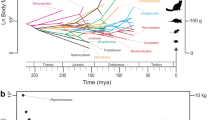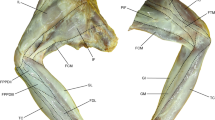Abstract
The nine-banded armadillo, Dasypus novemcinctus, is a member of the family Dasypodidae, which contains all extant species of armadillos and represents the most diverse group of xenarthran mammals by their speciation, form, and range of scratch-digging ability. This study aims to identify muscle traits that reflect specialization for fossorial habit by observing forelimb structure in D. novemcinctus and comparing it among armadillos using available myological data. A number of informative traits were observed in D. novemcinctus and among Dasypodidae, including the absence of m. rhomboideus profundus, the variable presence of a m. articularis humeri and m. coracobrachialis, two heads of m. triceps brachii with scapular origin, and a lack of muscle mass devoted to antebrachial supination. Muscle mass and myosin heavy chain (MHC) isoform content were also quantified from our forelimb dissections. New osteological indices are additionally calculated and reported for D. novemcinctus. Collectively, the findings emphasize muscle mass and power output for limb retraction and specialization of the distal limb for sustained purchase of soil by strong pronation and carpal/digital flexion. Moreover, the myological traits assessed here provide a valuable resource for interpretation of muscle architecture specializations among digging mammals and future reassessment of armadillo phylogeny.








Similar content being viewed by others
References
Aguiar JM, Fonseca GAB (2008) Conservation status of the Xenarthra. In: Vizcaíno SF, Loughry WJ (ed) The Biology of the Xenarthra. University Press of Florida, Gainesville, pp 215–231
Bezuidenhout AJ, Evans HE (2005) Anatomy of the woodchuck (Marmota monax). Am Soc Mammal, Stillwater
Copploe JV II, Blob RW, Parrish JHA, Butcher MT (2015) In vivo strains in the femur of the nine-banded armadillo (Dasypus novemcinctus). J Morphol doi: 10.1002/jmor.20387
Cuvier G, Laurillard M (1849) Recueil de Planches de Myologie. Dusacq, Paris
Delsuc F, Douzery EJP (2008) Recent advances and future prospects in xenarthran molecular phylogenetics. In: Vizcaíno SF, Loughry WJ (ed) The Biology of the Xenarthra. University Press of Florida, Gainesville, pp 11–23
Delsuc F, Superina M, Tilak M-K, Douzer EJP, Hassanin A (2012) Molecular phylogenetics unveils the ancient evolutionary origins of the enigmatic fairy armadillos. Mol Phylogenet Evol 62:673–680
Ercoli MD, Álvarez A, Stefanini MI, Busker F, Morales MM (2015) Muscular anatomy of the forelimbs of the lesser grison (Galictis cuja), and a functional and phylogenetic overview of the Mustelidae and other Caniformia. J Mammal Evol 22:57–91
Fisher RE, Adrian B, Barton M, Holmgren J, Tang ST (2009) The phylogeny of the red panda (Ailurus fulgens): evidence from the forelimb. J Anat 215:611–635
Galton JC (1869) The muscles of fore and hind limbs in Dasypus sexcinctus. Trans Linn Soc 26:523–565
Gambaryan PP (1974). How Mammals Run. John Wiley & Sons, New York
Gambaryan PP, Zherebtsova OV, Perepelova AA, Platonov VV (2009) Pes muscles and their action in giant anteater Myrmecophaga tridactyla (Myrmecophagidae, Pilosa) compared with other plantigrade mammals. Russian J Theriol 8:1–15
Gaudin TJ, Wible JR (2006) The phylogeny of living and extinct armadillos (Mammalia, Xenarthra: Cingulata): a craniodental analysis. In: Carrano MT, Gaudin TJ, Blob RW, Wible JR (ed) Amniote Paleobiology: Perspectives on the Evolution of Mammals, Birds, and Reptiles. University of Chicago Press, Chicago, pp 153–198
Hazimihalis PJ, Gorvet MA, Butcher MT (2013) Myosin isoform fiber type and fiber size in the tail of the Virginia opossum (Didelphis virginiana). Anat Rec 296:96–107
Hildebrand M (1985) Digging of quadrupeds. In: Hildebrand M, Bramble DM, Liem KF, Wake DB (ed) Functional Vertebrate Morphology. The Belknap Press of Harvard University Press, Cambridge, pp 89–109
International Committee on Veterinary Gross Anatomical Nomenclature (2012) Nomina Anatomica Veterinaria, 5th edn. Hannover, Germany; Columbia, MO; Ghent, Belgium; Sapporo, Japan: Editorial Committee
Iwaniuk AN, Pellis SM, Whishaw IQ (2000) The relative importance of body size, phylogeny, locomotion, and diet in the evolution of forelimb dexterity in fissiped carnivores (Carnivora). Can J Zool 78:1110–1125
Julik E, Zack S, Adrian B, Maredia A, Parsa A, Poole M, Starbuck A, Fisher RE (2012) Functional anatomy of the forelimb muscles of the ocelot (Leopardus pardalis). J Mammal Evol 19:277–304
Kley NJ, Kearney M (2007) Adaptations for digging and burrowing. In: Hall B (ed) Fins into Limbs. University of Chicago Press, Chicago, pp 284–309
Laemmli UK (1970) Cleavage of structural proteins during the assembly of the head of bacteriophage T4. Nature 227:680–685
Loughry WJ, McDonough CM (2013) The Nine-Banded Armadillo: A Natural History (Animal Natural History Series). University of Oklahoma Press, Norman
Macalister A (1875) A monograph of the anatomy of Chlamydophorus truncatus (Harlan), with notes on the structure of other species of Edentata. Trans R Irish Acad 25:219–278
McBee K, Baker RJ (1982) Dasypus novemcinctus. Mammal Species 162:1–9
McConathy D, Giddings CJ, Gonyea WJ (1983) Structure-function relationship of the flexor carpi radialis muscle among four species of mammals. J Morphol 175:279–292
McDonough CM, Loughry WJ (1997) Influences on activity patterns in a population of nine-banded armadillos. J Mammal 78:932–94.
Miles SS (1941) The shoulder anatomy of the armadillo. J Mammal 22:157–169
Mizunoya W, Wakamatsu J, Tatsumi R, Ikeuchi Y (2008) Protocol for high-resolution of rodent myosin heavy chain isoforms in a mini gel-electrophoresis system. Anal Biochem 377:111–113
Moore AL, Budny JE, Russell AP, Butcher MT (2013) Architectural specialization of the intrinsic forelimb musculature of the American badger (Taxidea taxus). J Morphol 274:35–48
Nowak RM (1999) Walker’s Mammals of the World, 6th ed. Johns Hopkins University Press, Baltimore
Nyakatura JA, Fischer MS (2011) Functional morphology of the muscular sling at the pectoral girdle in tree sloths: convergent morphological solutions to new functional demands? J Anat 219:360–374
Rood JP (1970) Notes on the behavior of the pygmy armadillo. J Mammal 51:179
Rose JA, Sandefur A, Huskey S, Demler JL, Butcher MT (2013) Muscle architecture and out-force potential of the thoracic limb in the eastern mole (Scalopus aquaticus). J Morphol 274:1277–1287
Rose JA, Moore AL, Russell AP, Butcher MT (2014) Functional osteology of the forelimb digging apparatus in badgers. J Mammal 95:543–558
Rupert JE, Cordero Schmidt E, Moriera-Soto A, Rodriguez Herrera B, VandeBerg JL, Butcher MT (2014) Myosin heavy chain (MHC) isoform expression in the prehensile tails of didelphid marsupials: functional differences between arboreal and terrestrial opossums. Anat Rec 297:1364–1376
Rupert JE, Rose JA, Organ JM, Butcher MT (2015) Forelimb muscle architecture and myosin isoform composition in the groundhog (Marmota monax). J Exp Biol 218:194–205
Samuels JX, Van Valkenburgh B (2008) Skeletal indicators of locomotor adaptations in living and extinct rodents. J Morphol 269:1387–1411
Samuels JX, Meachen JA, Sakai SA (2013) Postcranial morphology and locomotor habits of living and extinct carnivorans. J Morphol 274:121–146
Smith P (2008) Greater hairy armadillo Chaetophractus villosus. Mammals of Paraguay 11:1–15
Stalheim-Smith A (1984) Comparative study of the forelimbs of the semifossorial prairie dog, Cynomys gunnisoni, and the scansorial fox squirrel, Sciurus niger. J Morphol 180:55–68
Taber FW (1945) Contribution to the life history and ecology of the nine-banded armadillo. J Mammal 26:211–226
Talmadge RJ, Roy RR (1993) Electrophoretic separation of rat skeletal muscle myosin heavy-chain isoforms. J Appl Physiol 75:2337–2340
Talmage RV, Buchanan GD (1954) The Armadillo (Dasypus novemcinctus): A Review of Its Natural History, Ecology, Anatomy, and Reproductive Physiology. Rice Institute, Houston
Thewissen JG, Badoux DM (1986) The descriptive and functional myology of the fore-limb of the aardvark (Orycteropus afer, Pallas 1766). Anat Anz 162:109–123
Thorington RW Jr, Darrow K, Betts ADK (1997) Comparative myology of the forelimb of squirrels. J Morphol 234:155–182
Toniolo L, Cancellara P, Maccatrozzo L, Patruno M, Mascarello F, Reggiani C (2008) Masticatory myosin unveiled: first determination of contractile parameters of muscle fibers from carnivore jaw muscles. Am J Physiol Cell Physiol 295:1535–1542
Vaughn TA, Ryan JM, Czaplewski NJ (2013) Cingulata, Pilosa, and Pholidota. In: Mammalogy, 5th ed. Jones and Bartlett Publishers, Sudbury, Massachusetts, pp 147–160
Vizcaíno SF, Milne N (2002) Structure and function in armadillo limbs (Mammalia: Xenarthra: Dasypodidae). J Zool 257:117–127
Vizcaíno SF, Fariña RA, Mazzetta GV (1999) Ulnar dimensions and fossoriality in armadillos. Acta Theriol 44:309–320
Warburton NM, Grégoire L, Jacques S, Flandrin C (2013) Adaptations for digging in the forelimb muscle anatomy of the southern brown bandicoot (Isoodon obesulus) and bilby (Macrotis lagotis). Aust J Zool 61:402–419
Wilson DE, Reeder DM (2005) Mammal Species of the World. A Taxonomic and Geographic Reference, 3rd ed. Johns Hopkins University Press, Baltimore
Windle BCA, Parsons FG (1899) On the myology of the Edentata. Proc Zool Soc London 1899:314–339
Acknowledgments
We sincerely thank W. Loughry (Valdosta State University) and J. Copploe (YSU) for armadillo collection. A very special thanks to Theresanne DeMartino for the anatomical illustrations. We also thank M. Thornhill for preparation of muscle protein stocks and H. Suzuki for help with gel photography. The YSU Department of Biological Sciences and Ohio University Department of Biomedical Sciences are also gratefully acknowledged.
Author information
Authors and Affiliations
Corresponding author
Electronic supplementary material
Below is the link to the electronic supplementary material.
ESM 1
Intrinsic forelimb muscle mass distribution (JPEG 74 kb)
Appendices
Appendix 1
Appendix 2
Rights and permissions
About this article
Cite this article
Olson, R.A., Womble, M.D., Thomas, D.R. et al. Functional Morphology of the Forelimb of the Nine-Banded Armadillo (Dasypus novemcinctus): Comparative Perspectives on the Myology of Dasypodidae. J Mammal Evol 23, 49–69 (2016). https://doi.org/10.1007/s10914-015-9299-4
Published:
Issue Date:
DOI: https://doi.org/10.1007/s10914-015-9299-4




